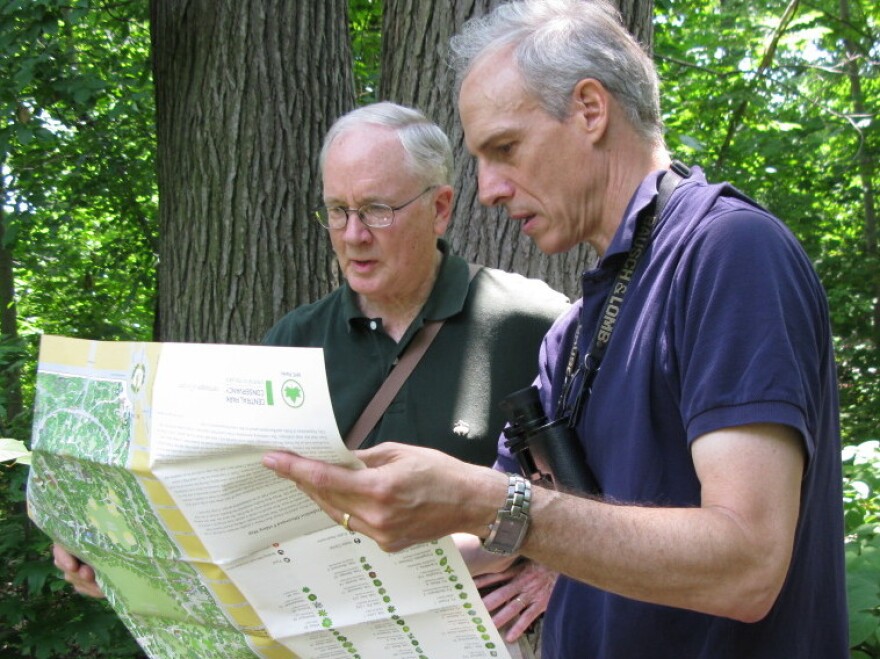With our free press under threat and federal funding for public media gone, your support matters more than ever. Help keep the LAist newsroom strong, become a monthly member or increase your support today.
Mapping (Almost) Every Tree In Central Park

There are more than 20,000 trees in New York City's Central Park and an author and birdwatcher have mapped almost every one of them.
Edward Barnard and Ken Chaya's map, "Central Park Entire," took them two and a half years to finish. Chaya walked thousands of miles in the park, mapping every tree and dirt trail.
Some of the oldest trees live in the northern part of the park. Barnard, the author of New York City Trees, points out a few of the species he sees: sweetgum, London plane and pin oak. He and Chaya, a longtime Central Park birder, see about 20 species from where they sit.
While Barnard was working on his book, he realized he needed a complete map of all the trees in the park. So he teamed up with Chaya, who became a student to Barnard's arboreal expertise.
As a birder, Chaya says, he thought it wouldn't be a hard task to map trees—unlike birds, they don't move. But as he became more involved in the mapping project, the park changed.

"It was like learning how to see new colors, or textures," Chaya says. "The park never looked the same again once I began to discover the many, many species of trees."
As they walk through the park, Chaya and Barnard come across two red oak tree stumps. The trees, Barnard says, were there before Frederick Law Olmstead and Calvert Vaux created the park in 1857. The trees fell during a storm two years ago. You can count 150 rings on one, but it's decades older than that, because the center is rotted out, Barnard says.
"We can easily see that this tree was here before the park," Chaya says, "and so, I love to imagine Vaux and Olmsted, standing here and saying, 'Look at that: two lovely young red oaks, maybe they will be big some day and we will plan the path around them.'"
Chaya and Barnard's map is 26 by 36 inches and shows 19,933 trees in their exact positions. Not every tree is mapped; some groves are marked by fewer trees than there are in the park.
Chaya points out the exact trees he's standing under. He points to two leaf-shaped marks — two sweetgums. The symbol represents the shape of that species' leaf, he says.
There's a slightly different shape for each species, and there are some color differences, but it's challenging; they're pretty similar.
"It's not easy to distinguish between 174 different small, green shapes," Chaya says. "I believe the map, like nature itself, is really meant to be studied."
But, the park is constantly changing. Chaya and Barnard look across a stream to the stump of a large pin oak. It was standing when the map was published a couple weeks ago.
Walking through the wildflower meadow, they find one of the park's treasures. As they duck under leaves, there's suddenly a hidden world under a huge American Beech tree.
"It's like standing in a green tent, underneath this tree, and right now no one is here. It is quiet," Chaya says.
As he spent more and more time in the park, he began to see its design.
"Olmsted used trees the way an artist uses colors," he says. "He used them to create curtains, walls, corners, and it looks natural. Many people think this is what Manhattan looked like before Central Park. Well, Central Park — before it was Central Park — was a desolate, rocky swamp."
These days, Central Park is full of thousands of plant and animal species. What was a swamp is now an arboretum. And now, there's a map.
Copyright 2022 NPR. To see more, visit https://www.npr.org. 9(MDA1OTI3MjQ5MDEyODUwMTE2MzM1YzNmZA004))








